香港大学:Solving Polynomial Equations(2006.12.5)
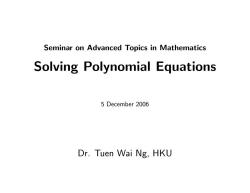
Seminar on Advanced Topics in Mathematics Solving Polynomial Equations 5 December 2006 Dr.Tuen Wai Ng,HKU
Seminar on Advanced Topics in Mathematics Solving Polynomial Equations 5 December 2006 Dr. Tuen Wai Ng, HKU
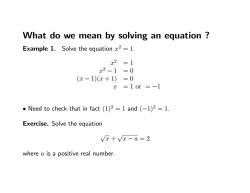
What do we mean by solving an equation Example 1.Solve the equation z2 -1. x2=1 x2-1=0 (x-1)(x+1) =0 x=10r=-1 Need to check that in fact (1)2=1 and (-1)2=1. Exercise.Solve the equation Vx+Vx-a=2 where a is a positive real number
What do we mean by solving an equation ? Example 1. Solve the equation x 2 = 1. x 2 = 1 x 2 − 1 = 0 (x − 1)(x + 1) = 0 x = 1 or = −1 • Need to check that in fact (1)2 = 1 and (−1)2 = 1. Exercise. Solve the equation √ x + √ x − a = 2 where a is a positive real number

What do we i mean by solving a polynomial equation Meaning I: Solving polynomial equations:finding numbers that make the polynomial take on the value zero when they replace the variable. We have discovered that z,which is something we didn't know,turns out to be 1 or-1
What do we mean by solving a polynomial equation ? Meaning I: Solving polynomial equations: finding numbers that make the polynomial take on the value zero when they replace the variable. • We have discovered that x, which is something we didn’t know, turns out to be 1 or −1

Example 2.Solve the equation z2=5. x2 =5 x2-5 =0 (x-V5)(x+V5) =0 =50r-vV5 C ●But what is√5?Well,V5 is the positive real number that square to5. We have "learned"that the positive solution to the equation z2-5 is the positive real number that square to 5 !! So there is a sense of circularity in what we have done here. Same thing happens when we say that i is a solution of x2=-1
Example 2. Solve the equation x 2 = 5. x 2 = 5 x 2 − 5 = 0 (x − √ 5)(x + √ 5) = 0 x = √ 5 or − √ 5 • But what is √ 5 ? Well, √ 5 is the positive real number that square to 5. • We have ”learned” that the positive solution to the equation x 2 = 5 is the positive real number that square to 5 !!! • So there is a sense of circularity in what we have done here. • Same thing happens when we say that i is a solution of x 2 = −1
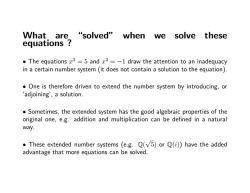
What are "solved"when we s solve t these equations The equations z2=5 and x2=-1 draw the attention to an inadequacy in a certain number system (it does not contain a solution to the equation). One is therefore driven to extend the number system by introducing,or adjoining',a solution. Sometimes,the extended system has the good algebraic properties of the original one,e.g.addition and multiplication can be defined in a natural way. .These extended number systems (e.g.Q(v5)or Q(i))have the added advantage that more equations can be solved
What are “solved” when we solve these equations ? • The equations x 2 = 5 and x 2 = −1 draw the attention to an inadequacy in a certain number system (it does not contain a solution to the equation). • One is therefore driven to extend the number system by introducing, or ‘adjoining’, a solution. • Sometimes, the extended system has the good algebraic properties of the original one, e.g. addition and multiplication can be defined in a natural way. • These extended number systems (e.g. Q( √ 5) or Q(i)) have the added advantage that more equations can be solved
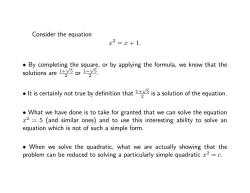
Consider the equation x2=x+1. By completing the square,or by applying the formula,we know that the solutions are 15 or 15 2 2 It is certainly not true by definition that5 is a solution of the equation. 2 What we have done is to take for granted that we can solve the equation z2=5 (and similar ones)and to use this interesting ability to solve an equation which is not of such a simple form. When we solve the quadratic,what we are actually showing that the problem can be reduced to solving a particularly simple quadratic 2=c
Consider the equation x 2 = x + 1. • By completing the square, or by applying the formula, we know that the solutions are 1+√ 5 2 or 1− √ 5 2 . • It is certainly not true by definition that 1+√ 5 2 is a solution of the equation. • What we have done is to take for granted that we can solve the equation x 2 = 5 (and similar ones) and to use this interesting ability to solve an equation which is not of such a simple form. • When we solve the quadratic, what we are actually showing that the problem can be reduced to solving a particularly simple quadratic x 2 = c
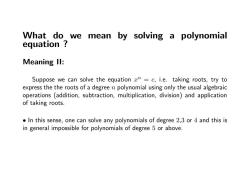
What do we i mean by solving a polynomial equation Meaning Il: Suppose we can solve the equation xT=c,i.e.taking roots,try to express the the roots of a degree n polynomial using only the usual algebraic operations (addition,subtraction,multiplication,division)and application of taking roots. In this sense,one can solve any polynomials of degree 2,3 or 4 and this is in general impossible for polynomials of degree 5 or above
What do we mean by solving a polynomial equation ? Meaning II: Suppose we can solve the equation x n = c, i.e. taking roots, try to express the the roots of a degree n polynomial using only the usual algebraic operations (addition, subtraction, multiplication, division) and application of taking roots. • In this sense, one can solve any polynomials of degree 2,3 or 4 and this is in general impossible for polynomials of degree 5 or above
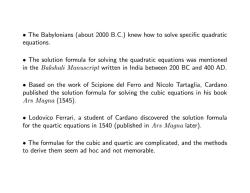
The Babylonians (about 2000 B.C.)knew how to solve specific quadratic equations. The solution formula for solving the quadratic equations was mentioned in the Bakshali Manuscript written in India between 200 BC and 400 AD. Based on the work of Scipione del Ferro and Nicolo Tartaglia,Cardano published the solution formula for solving the cubic equations in his book Ars Magna (1545). Lodovico Ferrari,a student of Cardano discovered the solution formula for the quartic equations in 1540 (published in Ars Magna later). The formulae for the cubic and quartic are complicated,and the methods to derive them seem ad hoc and not memorable
• The Babylonians (about 2000 B.C.) knew how to solve specific quadratic equations. • The solution formula for solving the quadratic equations was mentioned in the Bakshali Manuscript written in India between 200 BC and 400 AD. • Based on the work of Scipione del Ferro and Nicolo Tartaglia, Cardano published the solution formula for solving the cubic equations in his book Ars Magna (1545). • Lodovico Ferrari, a student of Cardano discovered the solution formula for the quartic equations in 1540 (published in Ars Magna later). • The formulae for the cubic and quartic are complicated, and the methods to derive them seem ad hoc and not memorable

Solving polynomial equations using circulant matrices D.Kalman and J.E.White,Polynomial Equations and Circulant Matrices,The American Mathematical Monthly,108,no.9,821-840,2001. Circulant matrices.An n x n circulant matrix is formed from any n-vector by cyclically permuting the entries.For example,starting with a b c we can generate the 3 x 3 circulant matrix (a b C= a b (1) 0 Circulant matrices have constant values on each downward diagonal,that is,along the lines of entries parallel to the main diagonal
Solving polynomial equations using circulant matrices D. Kalman and J.E. White, Polynomial Equations and Circulant Matrices, The American Mathematical Monthly, 108, no.9, 821-840, 2001. Circulant matrices. An n×n circulant matrix is formed from any n-vector by cyclically permuting the entries. For example, starting with [a b c] we can generate the 3 × 3 circulant matrix C = a b c c a b b c a . (1) • Circulant matrices have constant values on each downward diagonal, that is, along the lines of entries parallel to the main diagonal
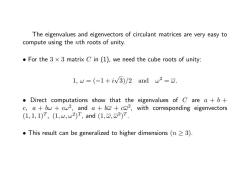
The eigenvalues and eigenvectors of circulant matrices are very easy to compute using the nth roots of unity. For the 3 x 3 matrix C in (1),we need the cube roots of unity: 1,w=(-1+iv3)/2andw2=o. Direct computations show that the eigenvalues of C are a+b+ c,a+bw +cw2,and a+bw+cw2,with corresponding eigenvectors (1,1,1)T,(1,w,w2)T,and(1,⑦,2)T. This result can be generalized to higher dimensions (n>3)
The eigenvalues and eigenvectors of circulant matrices are very easy to compute using the nth roots of unity. • For the 3 × 3 matrix C in (1), we need the cube roots of unity: 1, ω = (−1 + i √ 3)/2 and ω 2 = ω. • Direct computations show that the eigenvalues of C are a + b + c, a + bω + cω2 , and a + bω + cω 2 , with corresponding eigenvectors (1, 1, 1)T , (1, ω, ω2 ) T , and (1, ω, ω 2 ) T . • This result can be generalized to higher dimensions (n ≥ 3)
按次数下载不扣除下载券;
注册用户24小时内重复下载只扣除一次;
顺序:VIP每日次数-->可用次数-->下载券;
- 香港大学:Solving Polynomial Equations.pdf
- 香港大学:Games and the Mathematical Mind.pdf
- 香港大学:Seminar on Applications of Mathematics - Voting.pdf
- 香港大学:From Nash to Nash’s Game Theory.pdf
- 香港大学:博弈高手——浅论约翰·纳殊的诺具尔得理论.pdf
- 香港大学:谈情说数——跟爱情有关的数学.pdf
- 香港大学:《数趣漫话》谈情说数——跟爱情有关的数学.pdf
- 香港大学:拍卖中寻对策(PPT讲稿).pdf
- 佛山大学(佛山科学技术学院):2017版数学与应用数学(师范)专业理论课教学大纲汇编(合集).pdf
- 中国科学技术大学:几何建模与处理基础(PPT讲稿)细分曲线(主讲:刘利刚).pdf
- 同济大学:《高等数学》课程教学资源(预习PPT讲稿)第八章 向量代数与空间解析几何 第四节 空间直线及其方程.ppsx
- 同济大学:《高等数学》课程教学资源(预习PPT讲稿)第八章 向量代数与空间解析几何 第六节 空间曲线及其方程.ppsx
- 同济大学:《高等数学》课程教学资源(预习PPT讲稿)第八章 向量代数与空间解析几何 第五节 曲面及其方程.ppsx
- 同济大学:《高等数学》课程教学资源(预习PPT讲稿)第八章 向量代数与空间解析几何 第二节 数量积、向量积、混合积.ppsx
- 同济大学:《高等数学》课程教学资源(预习PPT讲稿)第八章 向量代数与空间解析几何 第三节 平面及其方程.ppsx
- 同济大学:《高等数学》课程教学资源(预习PPT讲稿)第八章 向量代数与空间解析几何 第一节 向量及其线性运算.ppsx
- 同济大学:《高等数学》课程教学资源(预习PPT讲稿)第三章 微分中值定理与导数的应用 第四节 函数的单调性与曲线的凹凸性.pps
- 同济大学:《高等数学》课程教学资源(预习PPT讲稿)第三章 微分中值定理与导数的应用 第五节 函数的极值与最大最小值.pps
- 同济大学:《高等数学》课程教学资源(预习PPT讲稿)第三章 微分中值定理与导数的应用 第七节 曲率.pps
- 同济大学:《高等数学》课程教学资源(预习PPT讲稿)第三章 微分中值定理与导数的应用 第三节 泰勒公式.pps
- ON-LINE LIST COLOURING OF RANDOM GRAPHS.pdf
- 西安电子科技大学:《线性代数》课程教学资源(PPT课件)线性代数机算与应用.ppt
- 西安电子科技大学:《线性代数》课程教学资源(讲义)线性代数讲义(共六章,主讲:李仁先).pdf
- 中国科学技术大学:《离散数学》课程教学资源(PPT课件讲稿)第一部分 数理逻辑 第一章 命题逻辑(主讲:肖明军).ppt
- 中国科学技术大学:《离散数学》课程教学资源(PPT课件讲稿)第一部分 数理逻辑 第二章 谓词逻辑.ppt
- 中国科学技术大学:《离散数学》课程教学资源(PPT课件讲稿)第二部分 集合论 第三章 集合代数.ppt
- 中国科学技术大学:《离散数学》课程教学资源(PPT课件讲稿)第二部分 集合论 第四章 二元关系.ppt
- 中国科学技术大学:《离散数学》课程教学资源(PPT课件讲稿)第二部分 集合论 第五章 函数.ppt
- 中国科学技术大学:《离散数学》课程教学资源(PPT课件讲稿)第二部分 集合论 第六章 集合的基数.ppt
- 中国科学技术大学:《离散数学》课程教学资源(PPT课件讲稿)第三部分 代数结构 第七章 代数系统.ppt
- 中国科学技术大学:《离散数学》课程教学资源(PPT课件讲稿)第三部分 代数结构 第八章 群论.ppt
- 中国科学技术大学:《离散数学》课程教学资源(PPT课件讲稿)第三部分 代数结构 第九章 环与域.ppt
- 中国科学技术大学:《离散数学》课程教学资源(PPT课件讲稿)第三部分 代数结构 第十章 格与布尔代数.ppt
- 中国科学技术大学:《离散数学》课程教学资源(PPT课件讲稿)第三部分 图论 第十一章 图的基本概念.ppt
- 中国科学技术大学:《离散数学》课程教学资源(PPT课件讲稿)第三部分 图论 第十二章 树.ppt
- 中国科学技术大学:《离散数学》课程教学资源(PPT课件讲稿)第三部分 图论 第十三章 几种特殊的图.ppt
- 《力学》课程教学资源(数学工具)力学数学预备知识——微积分初步.pdf
- 《力学》课程教学资源(数学工具)矢量分析与场论初步.pdf
- 《力学》课程教学资源(数学工具)张量的定义.pdf
- 《力学》课程教学资源(数学工具)张量与运算.pdf
